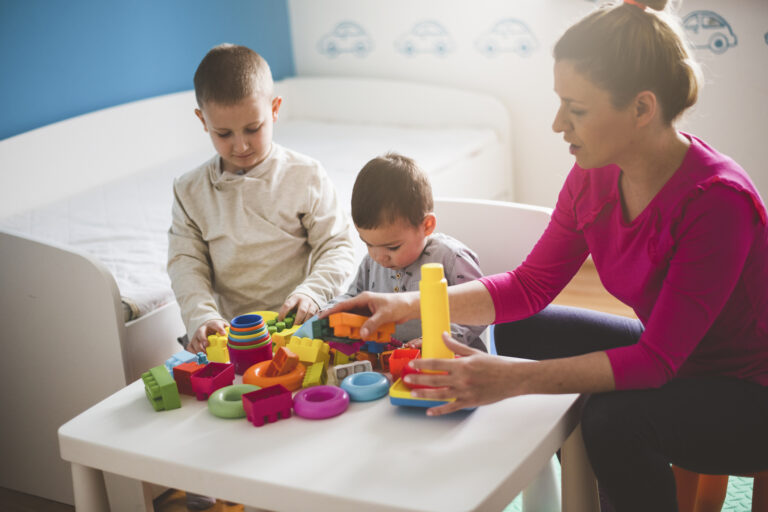Welcome to our blog post on “Setting Boundaries with Empathy: The Role of Therapeutic Parenting in Children’s Homes.” In this post, we will explore the concept of therapeutic parenting and its importance in creating a nurturing environment for children in residential settings.
Children’s homes play a crucial role in providing care and support to children who have experienced trauma or come from challenging backgrounds. However, establishing boundaries in such environments can be a delicate task. Traditional approaches to discipline and setting limits may not always be effective or appropriate for these vulnerable children.
That’s where therapeutic parenting comes into play. Therapeutic parenting is an approach that prioritizes empathy, understanding, and emotional connection in setting boundaries and guiding children’s behaviour. It recognizes that children who have experienced trauma or have attachment issues require a different approach to discipline and structure.
In this blog post, we will delve into the need for boundaries in therapeutic parenting and explore tools and techniques that can be used to set empathetic boundaries effectively. We will also discuss practical steps in implementing boundaries and how therapeutic parenting can positively impact children’s development.
Additionally, we will share case studies of successful therapeutic parenting in children’s homes, highlighting real-life examples of how this approach has made a difference in the lives of children. We will also address common challenges that arise in therapeutic parenting and provide strategies to overcome them.
Measuring the success of therapeutic parenting is crucial to ensuring continuous improvement and adjustment in the approach. We will explore key indicators of successful therapeutic parenting and discuss how to assess the impact of therapeutic parenting on children’s well-being.
Throughout this blog post, we will emphasize the importance of empathy and understanding in creating a safe and supportive environment for children in residential settings. By incorporating therapeutic parenting approaches, children’s homes can provide the necessary structure and care that these vulnerable children need to thrive.
Join us as we dive into the world of therapeutic parenting and discover how setting boundaries with empathy can transform the lives of children in residential care.
Understanding the Concept: Therapeutic Parenting and Its Importance in Children’s Homes
Therapeutic parenting is a unique approach that focuses on meeting the emotional and developmental needs of children in residential care. It recognizes that children who have experienced trauma or have attachment issues require a different parenting style than traditional approaches.
What is Therapeutic Parenting?
Therapeutic parenting involves creating a safe and nurturing environment that promotes healing, growth, and development. It is rooted in empathy, understanding, and building strong emotional connections with the child. This approach recognizes that children who have experienced trauma may have difficulty trusting and forming healthy attachments.
The Importance of Therapeutic Parenting in Children’s Homes
- Addressing Trauma: Many children in residential care have experienced trauma, which can have profound effects on their emotional well-being. Therapeutic parenting provides a framework for addressing and healing these traumas by providing a safe and supportive environment.
- Building Trust and Attachment: Children who have experienced neglect or abuse may struggle with forming secure attachments. Therapeutic parenting focuses on building trust and nurturing healthy relationships, which are essential for a child’s overall development.
- Promoting Emotional Regulation: Children who have experienced trauma often struggle with regulating their emotions. Therapeutic parenting helps children develop healthy coping mechanisms and emotional regulation skills, allowing them to navigate challenging situations more effectively.
- Creating a Sense of Belonging: Residential care can often feel impersonal and institutionalized. Therapeutic parenting aims to create a sense of belonging and connection for children in these settings, fostering a positive sense of identity and self-worth.
- Enhancing Social Skills: Children in residential care may have limited exposure to positive social interactions. Therapeutic parenting focuses on teaching and modelling appropriate social skills, helping children develop healthy relationships and navigate social situations successfully.
- Encouraging Personal Growth: Therapeutic parenting promotes personal growth and self-awareness by encouraging children to explore their strengths, interests, and goals. It provides opportunities for children to develop their talents, build resilience, and envision a positive future.
- Empowering Children: Therapeutic parenting empowers children by involving them in decision-making processes, respecting their autonomy, and encouraging their active participation in their own care. This approach helps children develop a sense of agency and ownership over their lives.
Understanding the concept of therapeutic parenting and its importance in children’s homes is crucial for creating an environment that nurtures the well-being and development of vulnerable children. By adopting this approach, children’s homes can provide the support, guidance, and love that these children need to heal and thrive.
How to Set Boundaries with Empathy
Setting boundaries with empathy is a fundamental aspect of therapeutic parenting. It involves creating a balance between providing structure and guidance while also considering the emotional needs and background of the child. In this section, we will explore the need for boundaries in therapeutic parenting, tools and techniques for setting empathetic boundaries, and practical steps to implement them effectively.
The Need for Boundaries in Therapeutic Parenting
- Safety and Security: Boundaries create a sense of safety and security for children, especially those who have experienced trauma. Clear boundaries help children understand what is expected of them and what is acceptable behaviour.
- Predictability and Consistency: Children thrive in environments that are predictable and consistent. Boundaries provide a framework for consistent expectations and consequences, helping children feel more secure and in control.
- Emotional Regulation: Boundaries help children develop emotional regulation skills by providing structure and guidance. They teach children how to manage their emotions appropriately and make healthy choices.
- Healthy Relationships: Boundaries play a crucial role in teaching children about healthy relationships and appropriate boundaries with others. By setting boundaries, children learn to respect personal space, express their needs, and establish healthy boundaries in their interactions with others.
Tools and Techniques for Setting Empathetic Boundaries
- Active Listening: Actively listening to the child’s perspective and concerns allows you to understand their needs and emotions better. This helps in setting boundaries that are sensitive to their individual experiences.
- Validation and Empathy: Validating the child’s emotions and experiences helps establish trust and understanding. Empathy allows you to set boundaries in a compassionate and understanding manner.
- Clear Communication: Clearly communicate the purpose and expectations of the boundaries. Use age-appropriate language and provide examples to ensure the child understands the boundaries.
- Collaborative Problem-Solving: Involve the child in the boundary-setting process whenever possible. This encourages their active participation and gives them a sense of ownership.
- Flexibility and Adaptability: Recognize that boundaries may need to be adjusted based on the individual needs and progress of the child. Be open to flexibility and adapt the boundaries as necessary.
Practical Steps in Implementing Boundaries
- Establish a Routine: Create a predictable daily routine that includes consistent expectations and boundaries. This helps children feel secure and understand what is expected of them.
- Set Clear Rules: Clearly communicate the rules and boundaries to the child. Use simple and concise language, and provide examples to help them understand.
- Use Positive Reinforcement: Recognize and reward positive behaviour when children adhere to the boundaries. This reinforces their understanding and encourages them to continue following the rules.
- Provide Logical Consequences: Establish consequences that are directly related to the behaviour. Ensure the consequences are fair, consistent, and focused on learning and growth rather than punishment.
- Offer Support and Guidance: Be available to support the child in navigating the boundaries. Provide guidance, explanations, and emotional support when needed.
By setting boundaries with empathy, therapeutic parents create a nurturing environment that supports the emotional well-being and growth of children in residential care. The tools, techniques, and practical steps discussed in this section can help establish boundaries that are sensitive to the child’s needs while promoting their development and overall well-being.
The Role of Therapeutic Parenting in Children’s Homes
The role of therapeutic parenting in children’s homes is paramount in creating an environment that promotes healing, growth, and positive development for vulnerable children. In this section, we will explore the impact of therapeutic parenting on children’s development, the incorporation of therapeutic parenting approaches in children’s homes, and share case studies of successful therapeutic parenting in action.
Impact of Therapeutic Parenting on Children’s Development
- Attachment and Bonding: Therapeutic parenting focuses on building secure attachments and nurturing healthy relationships between caregivers and children. This helps children develop trust, emotional security, and a sense of belonging, which are essential for their overall development.
- Emotional Regulation: Children who have experienced trauma often struggle with regulating their emotions. Therapeutic parenting provides a framework for teaching children healthy coping mechanisms, emotional regulation skills, and self-soothing techniques.
- Social Skills and Relationships: Children in residential care may have limited exposure to positive social interactions. Therapeutic parenting emphasizes the development of social skills, such as effective communication, empathy, and conflict resolution, enabling children to form healthy relationships and navigate social situations successfully.
- Self-Esteem and Identity: Therapeutic parenting aims to foster a positive sense of self-worth and identity in children. By providing unconditional love, acceptance, and validation, children can develop a healthy self-esteem and a strong sense of their own strengths and abilities.
- Cognitive and Academic Growth: Therapeutic parenting recognizes the importance of providing a stimulating and nurturing environment for children’s cognitive and academic development. This includes opportunities for learning, problem-solving, and intellectual exploration.
Incorporating Therapeutic Parenting Approaches in Children’s Homes
- Staff Training and Education: Children’s homes should prioritize staff training and education on therapeutic parenting approaches. This includes understanding trauma-informed care, attachment theory, and effective communication techniques.
- Creating a Therapeutic Environment: Children’s homes can create a therapeutic environment by implementing practices that promote safety, consistency, and emotional well-being. This may include establishing predictable routines, providing a sensory-friendly atmosphere, and offering spaces for privacy and reflection.
- Collaborative Care Planning: Collaborative care planning involves involving children, families, and professionals in decision-making processes regarding the child’s care. This approach ensures that the child’s needs and preferences are considered, and promotes a sense of empowerment and ownership.
Case Studies of Successful Therapeutic Parenting
- The Greenfields Children’s Home: The Greenfields Children’s Home implemented a therapeutic parenting approach, focusing on building secure attachments with the children in their care. Through consistent emotional support, guidance, and validation, the children experienced significant improvements in their emotional regulation, social skills, and self-esteem.
- The Willowbrook Residential Centre: At the Willowbrook Residential Centre, therapeutic parenting techniques were incorporated to address the specific trauma experienced by the children. By providing a safe and nurturing environment, implementing structured routines, and involving the children in decision-making, the centre witnessed remarkable improvements in the children’s emotional well-being, academic performance, and overall resilience.
These case studies highlight the positive impact of therapeutic parenting in children’s homes. By incorporating therapeutic parenting approaches and providing a nurturing environment, children’s homes can create a space where children can heal, grow, and thrive.
Overcoming Challenges in Therapeutic Parenting
Therapeutic parenting, while highly effective, can come with its own set of challenges. In this section, we will explore common difficulties faced in implementing therapeutic parenting, strategies to overcome these challenges, and the availability of resources and support for therapeutic parents.
Common Difficulties in Implementing Therapeutic Parenting
- Triggers and Reactions: Children who have experienced trauma may exhibit challenging behaviours, such as aggression, defiance, or withdrawal. Therapeutic parents may find it challenging to navigate these triggers and respond appropriately.
- Emotional Exhaustion: Providing the level of emotional support and guidance required in therapeutic parenting can be emotionally draining for caregivers. Balancing personal self-care and meeting the needs of the child can be a challenge.
- External Influences: Therapeutic parenting may face resistance or lack of understanding from external parties such as schools, social services, or family members. This can create additional stress and make it harder to maintain consistent therapeutic approaches.
- Lack of Training and Support: Therapeutic parenting requires specific knowledge and skills. Caregivers may face challenges if they lack proper training and ongoing support in implementing therapeutic parenting techniques.
Strategies to Overcome These Challenges
- Self-Care and Support: Therapeutic parents must prioritize their own well-being. Regular self-care practices, seeking support from other therapeutic parents or support groups, and seeking professional counselling can help manage emotional exhaustion.
- Continuous Education and Training: Engaging in ongoing training and education on trauma-informed care, therapeutic parenting techniques, and related topics can enhance therapeutic parents’ knowledge and skills. This can be done through workshops, conferences, online courses, or professional associations.
- Building a Support Network: Connecting with other therapeutic parents and professionals in the field can provide a support network for sharing experiences, seeking advice, and accessing resources.
- Collaborating with External Partners: Building positive relationships and open communication with schools, social services, and other stakeholders is crucial. Educating them about therapeutic parenting approaches and the child’s specific needs can help create a supportive environment.
Resources and Support for Therapeutic Parents
- Therapeutic Parenting Books and Literature: There are numerous books and resources available that provide guidance on therapeutic parenting techniques, trauma-informed care, and strategies for overcoming challenges. Some recommended books include “The Connected Child” by Karyn Purvis and “Beyond Consequences, Logic, and Control” by Heather T. Forbes.
- Online Communities and Forums: Online platforms offer spaces for therapeutic parents to connect, share experiences, seek advice, and find support from others who are on a similar journey.
- Professional Support: Seeking guidance from therapists, counsellors, or social workers who specialize in trauma-informed care and therapeutic parenting can provide valuable insights and support.
- Training Programs and Workshops: Many organizations offer training programs and workshops specifically designed for therapeutic parents. These programs provide knowledge, skills, and ongoing support to enhance therapeutic parenting practices.
By recognizing the common challenges in therapeutic parenting and implementing strategies to overcome them, caregivers can effectively navigate the complexities of this approach and provide the best possible care for the children in their homes. Accessing available resources and support networks is crucial in ensuring therapeutic parents have the necessary tools and assistance on their journey.
Measuring the Success of Therapeutic Parenting
Measuring the success of therapeutic parenting is essential to assess the impact of this approach on the well-being and development of children in residential care. In this section, we will explore key indicators of successful therapeutic parenting, discuss methods to assess the impact of therapeutic parenting on children, and highlight the importance of continuous improvement and adjustment in the therapeutic parenting approach.
Key Indicators of Successful Therapeutic Parenting
- Improved Emotional Regulation: Successful therapeutic parenting helps children develop healthy coping mechanisms and emotional regulation skills. This is evident when children can express and manage their emotions appropriately, handle stressors effectively, and demonstrate increased emotional resilience.
- Secure Attachments: Strong and secure attachments between children and caregivers are a key indicator of successful therapeutic parenting. Children who have experienced trauma may struggle with forming attachments, but through therapeutic parenting, they can develop trusting and healthy relationships with their caregivers.
- Positive Behavioural Changes: Successful therapeutic parenting leads to positive behavioural changes in children. This includes a decrease in challenging behaviours, an increase in prosocial behaviours, and the development of healthy communication and conflict resolution skills.
- Enhanced Self-Esteem and Self-Worth: Through therapeutic parenting, children should experience an improvement in their self-esteem and self-worth. They should develop a positive sense of identity, confidence in their abilities, and a belief in their own worthiness.
Assessing the Impact of Therapeutic Parenting on Children
- Observational Assessments: Regular observations by caregivers and professionals can provide insights into the child’s behaviour, emotional well-being, and their interactions with others. These observations can help assess the impact of therapeutic parenting on the child’s development.
- Self-Reports and Feedback: Encouraging children to share their thoughts, feelings, and experiences can provide valuable information about their perception of the therapeutic parenting approach. Feedback from children can help assess their level of comfort, trust, and satisfaction with the caregiving environment.
- Collaboration with Professionals: Collaborating with therapists, social workers, and other professionals involved in the child’s care can provide additional perspectives on the child’s progress and the effectiveness of therapeutic parenting techniques.
- Outcome Measures and Assessments: Utilizing standardized measures and assessments, such as questionnaires or scales, can provide quantitative data to measure the child’s progress in various domains, including emotional well-being, attachment, and behavioural changes.
Continuous Improvement and Adjustment in the Therapeutic Parenting Approach
Therapeutic parenting is an ongoing process that requires continuous improvement and adjustment. Caregivers should regularly reflect on their practices, seek feedback from professionals and support networks, and make necessary adjustments to meet the changing needs of the child.
- Reflective Practice: Engaging in reflective practice allows caregivers to critically analyse their interactions and approaches, identify areas for improvement, and make adjustments accordingly.
- Professional Development: Continuously expanding knowledge and skills through professional development opportunities helps caregivers stay updated with the latest research, techniques, and best practices in therapeutic parenting.
- Child-Centred Approach: Recognizing that each child is unique and may respond differently to therapeutic parenting approaches is important. Adjustments should be made based on the individual needs, preferences, and progress of each child.
- Collaboration and Support: Seeking guidance and support from professionals, support networks, and fellow therapeutic parents can provide valuable insights and assistance in continuously improving the therapeutic parenting approach.
By measuring the success of therapeutic parenting, caregivers can ensure that they are effectively meeting the needs of children in residential care. Regular assessments, feedback, and adjustments contribute to the continuous improvement of therapeutic parenting practices, ultimately leading to positive outcomes for children’s well-being and development.
Related posts:
 Promoting Emotional Regulation: Therapeutic Parenting Approaches in Children’s Homes
Promoting Emotional Regulation: Therapeutic Parenting Approaches in Children’s Homes
 Beyond Surface-Level: Diving Deep into Understanding a Child’s Behaviour
Beyond Surface-Level: Diving Deep into Understanding a Child’s Behaviour
 The Power of Observation: Exploring the Meaning Behind a Child’s Behaviour
The Power of Observation: Exploring the Meaning Behind a Child’s Behaviour
 Building Empathy and Connection: Developing Insights into a Child’s Behaviour
Building Empathy and Connection: Developing Insights into a Child’s Behaviour



